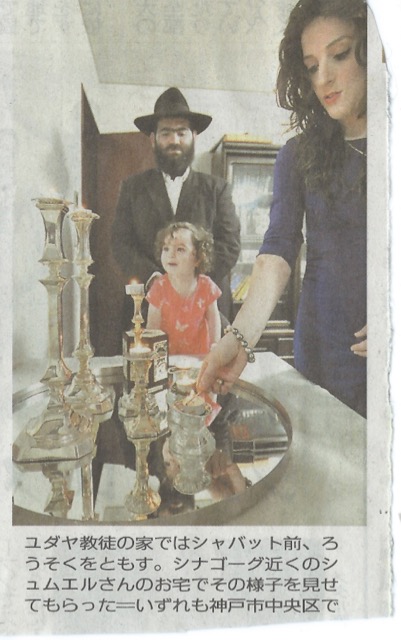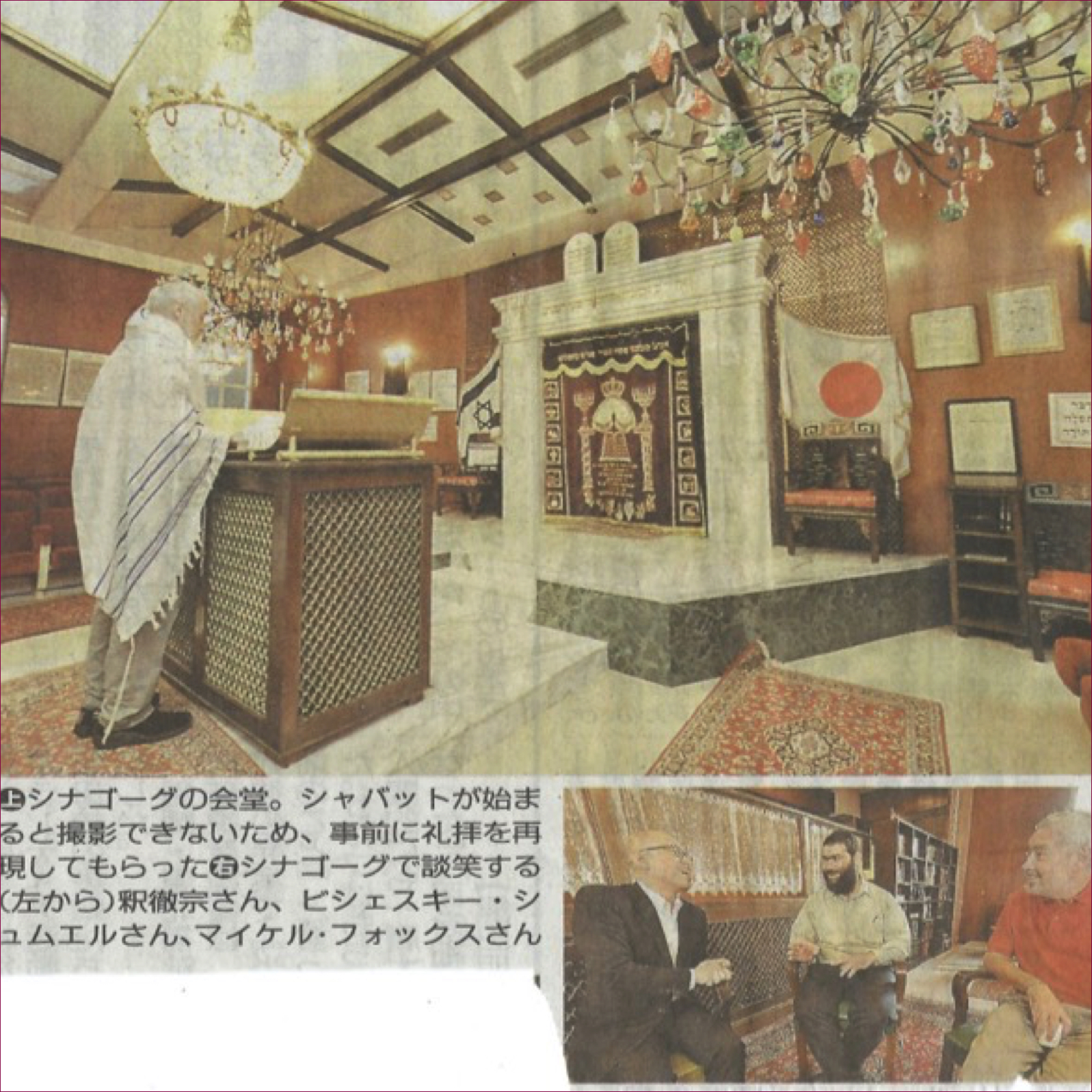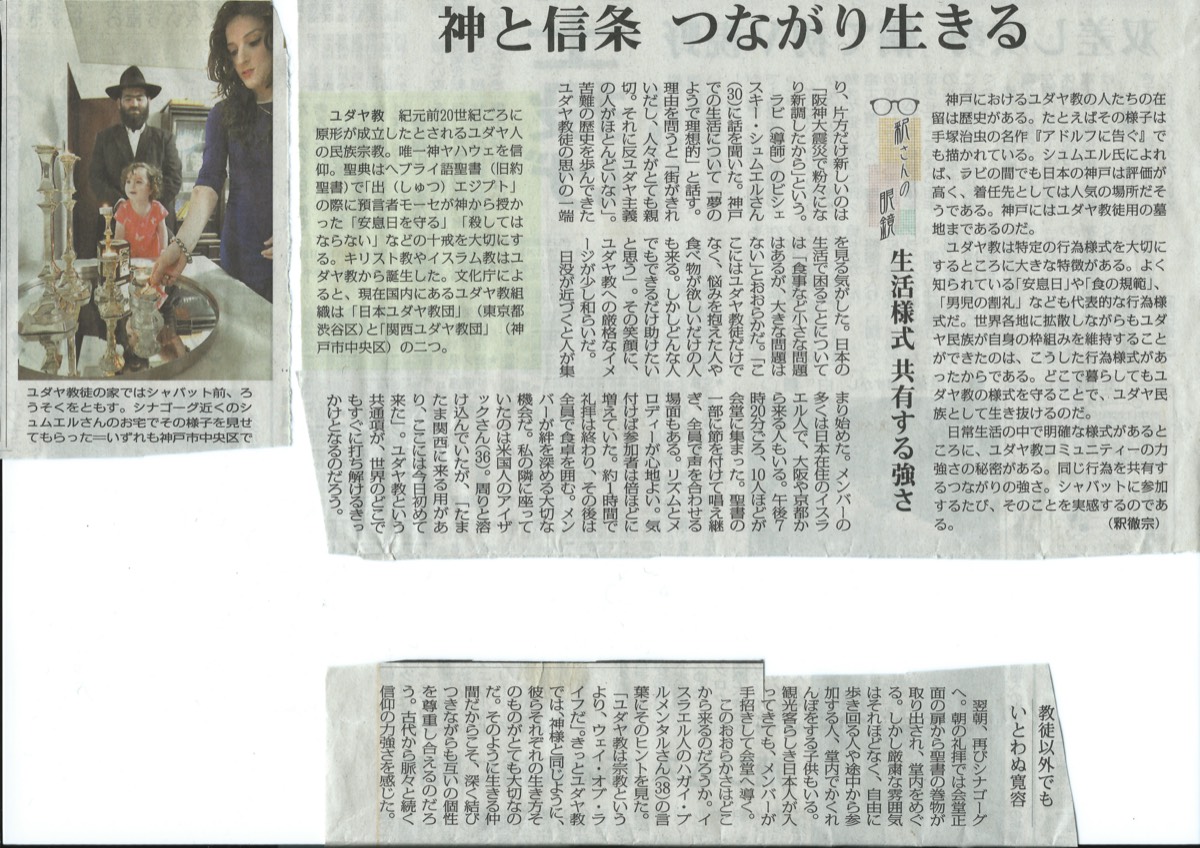The Kobe Synagogue: Activities on the Day of the Rest
Mainichi Shinbun (Mainichi Newspaper)
Friday July 24, 2015
translated from the Japanese
by Michael H. Fox
(Note Japanese original article listed below. (日本語原文は下記に添付。)
The Jewish religion is one of the oldest in the world. Though not very familiar to Japan, the Kobe Synagogue "Kansai Yudaya Kyoudan" located near the Ijinkan in Kitano has a history of over 80 years. In order to look at the prayers of the heart of the Jewish lifestyle (shabbat), Jodo Shinshu priest and religions scholar Shaku Tesshu-san visited the synagogue. (story and pictures by Shigeto Hanasawa-reporter)
〜〜〜〜〜〜〜〜〜〜〜〜〜〜〜〜〜〜〜〜〜〜〜〜〜〜


Right: Engaging in conversation are left to right, Tesshu Saku, Rabbi Shmuel Vishedsky, and Michael Fox.
~~~~~~~~~~~~~~~~~~~~~~~~~~~~~~~~~~~~~~~~~~~~~~~~~~~~~~~~~~~~~~~~~~~~~~~~~~~~~~~~~~~
Our Neighbors of a Different Religion:
Section on Judaism
Shabbat is the seventh day on which God rested, and runs from sunset on Friday until sunset on Saturday. Jewish people do absolutely no work, and offer prayers quietly. Most people do not use telephones, take photographs, write with pens, let alone drive cars or cook.
It was the first Friday of July. Shaku-san's friend who attends the synagogue, Michael Fox (aged 58), associate professor at Hyogo University, showed us around. At the doorway Fox-san placed a small circular cloth on his head, "When praying, we put these on." It is a kind of covering called a "kipah", which shows reverence toward God. This comes as quite a surprise to Japanese who uncover their heads at Shinto shrines or in front of Buddhist altars.
Prayers and Meals: A Place for Sharing.
The interior is divided between a sanctuary and a dining area. The rear of the sanctuary has a section for women. Facing the front of the sanctuary is a gate like structure covered with a curtain which contains the holy scrolls. At the top are the ten commandments written on two stones. One of them is cracked after falling in the great Hanshin Earthquake (Jan 17, 1995).
We spoke with Rabbi Shmuel Vishedsky(aged 30). "Our lifestyle in Kobe is, ideal-like a dream." In regard to what is ideal, he explained "the streets are clean, and the people are kind. And we don't worry about anti-semites.'" Hearing this comment, I was able to see the history of suffering which has befallen the Jews.
What problems does he have about life in Japan? "We have small problems about meals, but no severe problems" he stated comfortably. "This place is not only for Jews, but for all who bear sufferings and those who beg for food. We try to help all." Glimpsing the rabbi's gentle face, the severe image Japanese have of Judaism melts away.
With the nearing of the sunset, people begin to arrive. Most of the members are Israeli residents, and some come from Osaka and Kyoto. By 7:20, ten people had assembled. They read the prayer books together in unison. The rhythms and melodies are comforting. Suddenly, the number of participants has doubled.
After close to one hour of prayers, all surround the dinner table. It is an important time for the community to deepen bonds. Sitting next to me is an American named Isaac( age 36). Though he appears comfortably merged within a familiar group, he says, "I sometimes come to Kansai for work, but this is my first time attending this synagogue." Perhaps, the commonality of Judaism allows strangers to easily mix together anywhere in the world.
Hospitality toward other religions
The next morning, Saturday, I arrive at the synagogue. During the morning prayer service, the torah scrolls are taken out from the ark and carried around the hall. But the atmosphere is not one of strict silence, some people are walking about, some enter in the middle of the service, and some children appear to be playing hide and seek. When Japanese tourists enter, hands are extended and the visitors are welcomed into the prayer hall.
I wonder where this generosity comes from? I got a hint from speaking with Hagay Blumenthal (aged 38). "Judaism is more than a religion, it is a way of life." In Judaism, it certainly seems that how one lives is equally important to faith in God. And among those who live this way, human bonds are deepened and individuality is respected. I felt a power of faith that has been continued ceaselessly from ancient times.
~~~~~
Through Shaku-san's Lenses
Behavioral traditions=commonality of strength.
by Tesshu Shaku
The presence of Jews of Kobe is itself history. Even Cartoonist Tezuka Osamu wrote about them in his masterpiece "Message to Adolph." Rabbi Shmuel mentioned that among Rabbi's, Kobe is considered a very good and popular place to be posted. There even is a Jewish cemetery.
Judaism has unique behavioral traditions with important meanings. Better known among these are the sabbath, dietary prescriptions, and male circumcision.
While spreading throughout the world, these behavioral traditions have helped the Jews maintained their ethnic identity. Wherever they live, the Jews observe their traditions, and the Jewish ethnicity has survived.
Observing these precise traditions in everyday life is the secret of the Jewish community's strength. A strength in the commonality and bonds of behavior. All these things can be felt through participation in the sabbath.
~~~~~~~~~~~~~~~~
Sidebar: Judaism
Approximately 2000 BCE, the original pattern of the ethnic religion of the Jews were formed. Belief is in the single God of Yahveh. The scriptures are the Hebrew bible ( the old testament) which places importance on the ten commandments, i.e., observance of the sabbath day, do not murder, etc., and which were received by Moses during the exodus from Egypt. Christianity and Islam were born out of Judaism. According to the Department of Cultural Affairs, there are two Jewish organizations in Japan: The Jewish Community of Japan (Shibuya-ku, Tokyo); and The Jewish Community of Kansai (Chuo-ku, Kobe).
The End
~~~~~~~~~~~~~~~~~~~~~~~~~~~~~~~~~~~~~~~~~~~~~~~~~~~~~~~~

